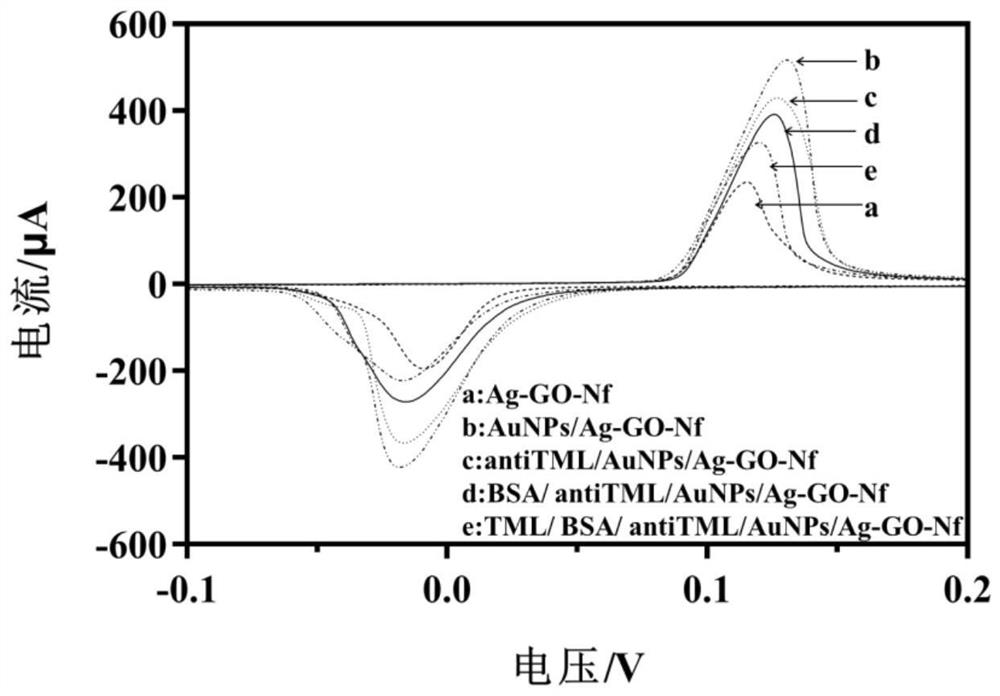Electrochemical immunosensor for detecting tiamulin antigen and preparation method thereof
An immunosensor, tiamulin technology, applied in the direction of material electrochemical variables, scientific instruments, instruments, etc., can solve the problem of few electrochemical immunoassay methods, achieve faster electron transfer, improve sensitivity, and lower detection limit Effect
- Summary
- Abstract
- Description
- Claims
- Application Information
AI Technical Summary
Problems solved by technology
Method used
Image
Examples
Embodiment 1
[0046] (1) The gold electrode is used as the basic electrode, and Al of 1.0, 0.3 and 0.05 μm 2 o 3 Grind the polishing powder to a mirror surface, then sonicate in absolute ethanol for 3 minutes, N 2 blow dry;
[0047] (2) Dissolve 10 mg of graphene oxide in an aqueous solution and ultrasonically disperse it for 3 hours, then add 0.5 g of glucose to the above aqueous solution under stirring to obtain solution A; 0.55M NH 3 ·H 2 O was slowly added to 6.7 mL with a concentration of 0.18 MAgNO 3 solution, solution B was obtained; solution B was slowly added to solution A, magnetically stirred for 8 minutes and then left at room temperature for 1.5 hours to obtain solution C; solution C was centrifuged at 12000 rpm for 5 minutes, the supernatant was discarded, and washing the precipitate with deionized water several times until the pH of the solution is neutral, and then drying the washed precipitate at 60°C for 16 hours to obtain the silver-graphene oxide nanomaterial;
[00...
Embodiment 2
[0068] (1) With the gold electrode as the basic electrode, 1.0, 0.3 and 0.05 μm Al 2 o 3 The polishing powder is polished to a mirror surface, and then ultrasonicated in deionized water for 5 minutes, N 2 blow dry;
[0069] (2) Dissolve 10 mg of graphene oxide in an aqueous solution and ultrasonically disperse it for 1 hour, then add 0.7 g of glucose to the above aqueous solution under stirring to obtain solution A; 3 ·H 2 O was slowly added to 8 mL of 0.06M AgNO 3 solution, solution B was obtained; solution B was slowly added to solution A, magnetically stirred for 9 minutes and then left at room temperature for 1 hour to obtain solution C; solution C was centrifuged at 10,000 rpm for 3 minutes, the supernatant was discarded, and washing the precipitate with deionized water several times until the pH of the solution is neutral, and then drying the washed precipitate at 50°C for 24 hours to obtain the silver-graphene oxide nanomaterial;
[0070] (3) Grind the silver-graph...
Embodiment 3
[0075] (1) The gold electrode is used as the basic electrode, and Al of 1.0, 0.3 and 0.05 μm 2 o 3 The polishing powder is polished to a mirror surface, and then ultrasonicated in absolute ethanol for 8 minutes, N 2 blow dry;
[0076] (2) Dissolve 10 mg of graphene oxide in an aqueous solution and ultrasonically disperse it for 5 hours, then add 0.3 g of glucose to the above aqueous solution under stirring to obtain solution A; 3 ·H 2 O was slowly added to 5mL with a concentration of 0.27M AgNO 3 solution, solution B was obtained; solution B was slowly added to solution A, magnetically stirred for 10 minutes and then left at room temperature for 2 hours to obtain solution C; solution C was centrifuged at a speed of 13000 rpm for 6 minutes, the supernatant was discarded, and The precipitate was washed with deionized water several times until the pH of the solution was neutral, and then the washed precipitate was dried at 80° C. for 12 hours to obtain the silver-graphene oxi...
PUM
 Login to View More
Login to View More Abstract
Description
Claims
Application Information
 Login to View More
Login to View More - R&D
- Intellectual Property
- Life Sciences
- Materials
- Tech Scout
- Unparalleled Data Quality
- Higher Quality Content
- 60% Fewer Hallucinations
Browse by: Latest US Patents, China's latest patents, Technical Efficacy Thesaurus, Application Domain, Technology Topic, Popular Technical Reports.
© 2025 PatSnap. All rights reserved.Legal|Privacy policy|Modern Slavery Act Transparency Statement|Sitemap|About US| Contact US: help@patsnap.com



